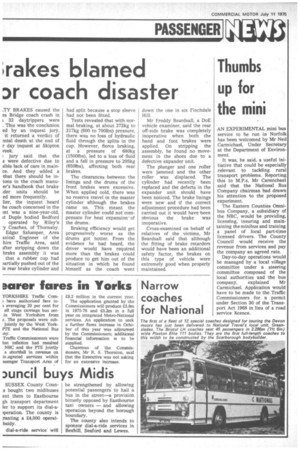Takes blamed
Page 40

If you've noticed an error in this article please click here to report it so we can fix it.
Dr coach disaster ,TY BRAKES caused the as Bridge coach crash in 32 daytrippers were . This was the conclusion ed by an inquest jury, it returned a verdict of mtal death at the end of r day inquest at Skipton veek.
jury said that the s were defective due to 5ible lack of care in mainee. And they added a that there should be inions in the coach manuer's handbook that brake der units should be ed more frequently.
her, the inquest heard he coach concerned in the .rit was a nine-year-old, it Duple bodied Bedford operated by Riley's y Coaches, of Thornaby. Edgar Szlimper, Area inical Engineer of the hire Traffic Area, said ifter stripping down the brake assembly it was that a rubber cup had )artially pushed out of the Le rear brake cylinder and had split because a stop sleeve had not been fitted.
Tests revealed that with normal braking, at about 272kg to 317kg (600 to 7001bs) pressure, there was no loss of hydraulic fluid through the splits in the cup. However, fierce braking, at a pressure of 680kg (15001bs), led to a loss of fluid and a fall in pressure to 295kg (6501bs), affecting both rear brakes.
The clearances between the linings and the drums of the front brakes were excessive. When 'applied cold, there was no reserve travel in the master cylinder although the brakes came on. This meant the master cylinder could not compensate for heat expansionof the drums.
Braking efficiency would get progressively worse as the drums got hotter. From the evidence he had heard, the driver would have required more than the brakes could produce to get him out of the situation in which he found himself as the coach went down the one in six Finchdale Hill.
Mr Freddy Beardsall, a DoE vehicle examiner, said the rear off-side brake was completely inoperative when both the hand and foot 'brakes were applied. On stripping the assembly, he found no movement in the shoes due to a defective expander unit.
The plunger and one roller were jammed and the other roller was displaced. The cylinder had recently been replaced and the defects in the expander unit should have been noticed. The brake linings were new and if the correct adjustment procedure had been carried out it would have been Obvious the brake was inoperative.
Cross-examined on behalf of relatives of the victims, Mr Beardsall said that although the fitting of brake retarders would have been an additional safety factor, the brakes on this type of vehicle were extremely good when properly maintained.












































































































































